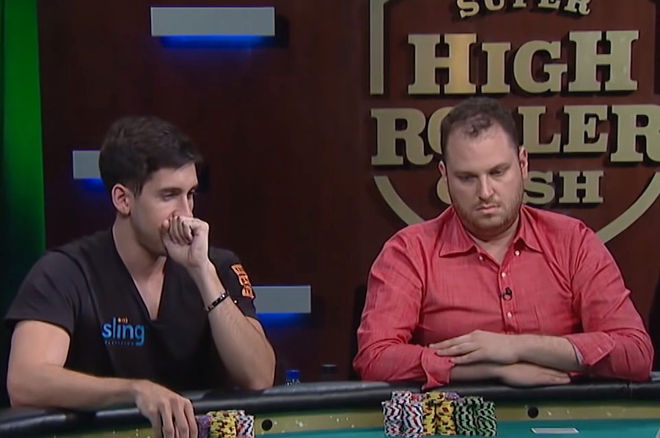Another Deep-Stacked Cash War: Scott Seiver vs. Dan Colman

Covering live poker tournaments for a living affords me the opportunity to see countless thousands of hands played out, many of which offer interesting and potentially valuable insights into how players — both amateurs and professionals — play the game. In this ongoing series, I’ll highlight hands I’ve seen at the tournaments I’ve covered and see if we can glean anything useful from them.
The Scene
We’ve been zigging and zagging between tournament poker and cash games in this space, and this week the pendulum swings back to cash games as we look back at a big hand from the Super High Roller Cash Game at the ARIA Resort & Casino last summer.
This hand comes from Day 2 of the game which featured an all-star cast of some of the sharpest players in the world playing with $400/$800 blinds and a $200 ante. At this point in the game, Scott Seiver was the big winner, having built up a stack of about $621,000 after having initially sat down for $250,000. Dan Colman was also ahead and had $583,000 after buying in for $450,000.
The Action
After a fold under the gun, Andrew Robl made it $2,400 to go holding 8♥8♠. Colman then three-bet from the next seat with A♥A♦ to $8,500. Seiver was next to act from the button, and with 9♦9♣ he cold four-bet to $24,000. That chased away the blinds, as well as Robl. Colman, of course, wasn’t going anywhere, and he five-bet to $70,000. Seiver called, bringing a flop of 9♠2♦K♥.
Colman bet out $50,000, and Seiver called. The turn brought the 3♥, and this time Colman checked. Seiver pushed out a double-fisted bet of $120,000. Colman called, and the dealer brought the 8♦ out to complete the board. Colman checked again and Seiver said he was all in, putting Colman at risk for $343,200.
“You really just have kings?” Colman said with a smile. “Scott, Scott, Scott, that’s all you could have right? Kings? Just kings? I have aces.”
One by one, Colman slowly slid his aces to the dealer, and Seiver dragged the pot. Take a look:
Concept and Analysis
This was one of my favorite hands that I saw all summer, one that I immediately texted all of my friends about during the live stream to see what they thought. It really illustrates the complexity of deep-stacked no-limit games and how tough decisions can become.
Robl and Colman play their hands pretty straightforwardly with raises and reraises, respectively, before Seiver makes the decision to cold four-bet his nines. I think you can make a case for Seiver calling, raising, and even folding in this spot, given how aggressively Robl had been playing and — in my recollection, at least — that Colman had been one of the tighter players at the table.
In any case, Colman comes back with the five-bet after Robl sensibly folds, and Seiver has an interesting decision. It’s $46,000 more to call, and Colman has just over $500,000 back, so Seiver’s implied odds are about 11-to-1. Is it profitable to set-mine at that price?
Personally, I don’t think so, especially against an excellent player like Colman who is capable of sniffing out big hands and making big folds. Seiver can still call though, if he thinks there are hands in Colman’s range that he beats, and he thinks he can use his position to bluff Colman on certain boards.
Of course, Seiver flops his set. He decides to flat-call Colman’s one-third pot flop bet, leading to Colman checking the turn for pot control as the board reads 9♠2♦K♥3♥. Seiver bets half-pot. Colman has to be worried about a set of kings, but he again calls, as folding is far too weak against a player of Seiver’s caliber who is capable of making moves.
The 8♦ river then completes a relatively dead board where no straights or flushes are possible, and Seiver puts Colman all in for $343,200 to make a pot of $828,000. It’s an especially sick spot for Colman because Seiver has credibly represented two kings in the hole the entire way. Everything fits — getting in a five-bet pot preflop, flatting a non-threatening flop with top set, betting the turn, and shoving the river.
The problem from Colman’s perspective is that his hand looks like aces, and Seiver is a good enough player that he knows he can represent kings and likely get Colman to fold. When I watched this hand without knowing the hole cards, I thought Seiver must have a set of kings or nothing, but either way I figured Colman had little choice but to believe him and fold.
That’s why this would have been such an awesome spot to bluff all in. Your opponent can really only call you if he has a set of kings. Because Colman is so good, we can expect he’d have played a set of kings the same way for balancing purposes, so Seiver’s shove definitely has the potential to cost him his stack.
In the end, though I was a little off on Seiver’s holding, he doesn’t end up getting paid off as Colman makes the disciplined laydown. The only thing that would have made this hand more awesome? If Seiver actually turned over a bluff in an amazing spot for it.









